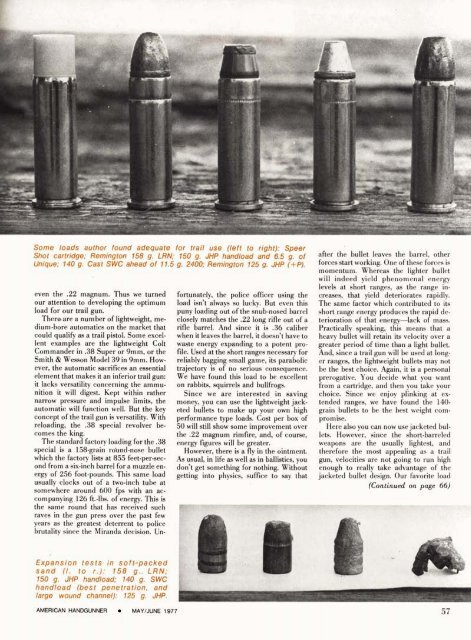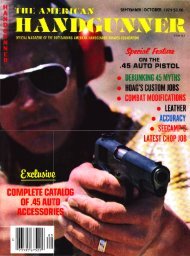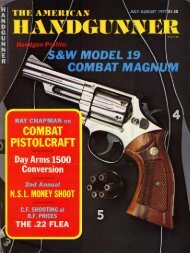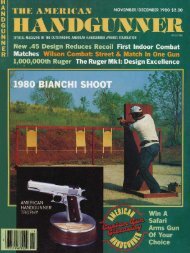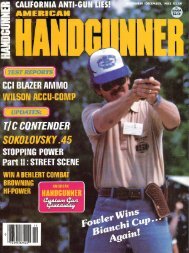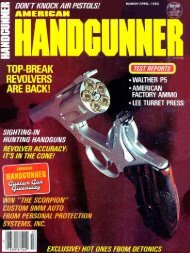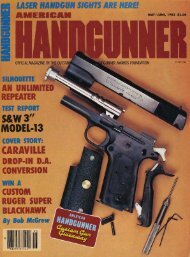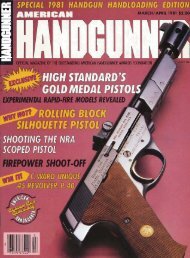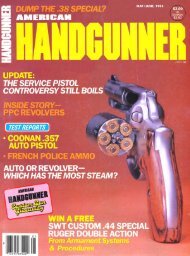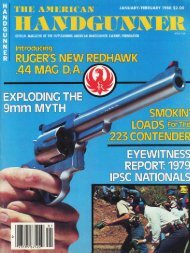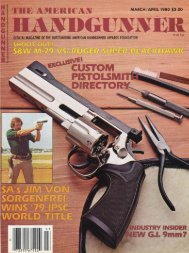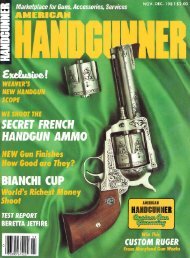Jroup fired offhand from 25 yards using a two-hand hold demonstratds, the excellent trail-use accuracy obtainable with the Colt Diamohdback.before, most of the shooting done with atrail gun will be at small game and varmints.Though we probably all have readof instances in which a .22 long rifle hastaken large game, even some of the dangerousAfrican species, the question is gettingenough power to do the job intended.In our opinion, the .22 long rifle, in alightweight pistol, does not have sufficientpower. Even out of a six-inch barrel,the .22 long rifle high velocity round developsonly 112 foot-pounds of energy atthe muzzle. Put another way, the .22 longrifle develops aboilt the same energy froma short pistol barrel as the .22 short developsfrom a rifle barrel. In our opinion, itcannot be relied upon, especially whentaking the larger varmints such as thewoodchuck and fox.The .22 magnum rimfire is a much betterchoice. In fact, with the excellent kitguns made by Smith & Wesson arid HighStandard in .22 magnum caliber, and withthe excellent single action versions marketedby Ruger and Colt, we were at firstinclined to choose this load as the perfectcompromise for trail lise. However, afterpurchasing two boxes of this mighty miteat slightly over $3.00 a box, we began tolook around for a smaller load in centerfirethat could be reloaded for less money.The k wer was the .38 special. Here isa cartridge that is available in a multitudeof lightweight handguns. And, since it isthe standard load for the majority of<strong>American</strong> police forces, reloading componentswere varied and plentiful. Most iifaportantly,even in the short-barreled models,energy figures were much better thaneven a short carbine, and sacrifice a bit ofcomfort for the extra margin of power andaccuracy which these guns would provide.In other words, a trail gun should be a versatiletool, rather than a weapon aimedtoward a particular function such as biggame hunting.However, it would be comforting toknow that the trail gun one was carryingwas capable of taking medium sized gamein an emergency situation, since, by definition,the trail gun would be the gun mostlikely carried on hiking trips, fishing trips,and such occasions where survival situationsmight arise.But the primary purpose of the trail gunwill most often be generalized: plinking,potting small game, taking an occasionalwoodchuck or other varmint, with maybean occasional opportunity to eliminate apesky rattler or cottonmouth. Thus, thegun's power requirements are not reallythat high.Finally, the trail gun has to be accurate.It has to be capable of putting that squirrelor rabbit in the pot. And perhapsequally important, it has to be cheapenough to feed so that its user will be encouragedto shoot it often enough in orderto learn to shoot it well.If one takes some time and looks over56these criteria of weight, power and accuracy,then it becomes obvious that a compromisehas to be reached. Obviously,more power and accuracy can be obtainedfrom a rifle than from a pistol. Equally obviousis the fact that no rifle can match thepistol for its portability and light weight. Itis this author's opinion that the best compromiseis to found in the .38 special cartridgeand the guns chambered for it.Concerning weight, there are a numberof fine pistols that fill the bill. Any of thelight-framed revolvers with barrels of 4"or less suit the requirements of a trail gun.Using a snub-nosed .38 as a trail gun hasan added bonus for those who must sometimescarry a weapon in their work, or forthose who keep a pistol around the housefor personal defense. By carrying andshooting the pistol in the field, one cangain valuable experience in marksmanshipand handling that could pay high dividendsin a more serious social situation.It is often hard to make time for themuch-needed practice with a defense pistol.Carrying the pistol with you into thefield in a painless and enjoyable way to obtainthe necessary practice.Power is perhaps the crucial elementthat led us to the conclusion that the .38special is the perfect trail gun. As statedTypical seven-yard pattern firedfrom a Diamondback demonstratesadequate grouping to bag smallgame in an emergency situation.AMERICAN HANDGUNNER MAY/JUNE <strong>1977</strong>
Some loads author found adequate for trail use (left to right): SpeerShot cartridge; Remington 158 g. LRN; 150 g. JHP handload and 6.5 g. of after the leaves the otherUnique; 140 g. Cast SWC ahead of 11.5 g. 2400; Remington 125 g. JHP (+ P). start One these ismomentum. Whereas the lighter bulleteven the .22 magnum. Thus we turnedour attention to developing the optimumload for our trail gun.There are a number of lightweight, medium-boreautomatics on the market thatcould qualify as a trail pistol. Some excellentexamples are the lightweight ColtCommander in .38 Super or 9mm, or theSmith & Wesson Model 39 in 9mm. However,the automatic sacrifices an essentialelement that makes it an inferior trail gun:it lacks versatility concerning the ammunitionit will digest. Kept within rathernarrow pressure and impulse limits, theautomatic will function well. But the keyconcept of the trail gun is versatility. Withreloading, the .38 special revolver becomesthe king.The standard factory loading for the .38special is a 158-grain romd-nose bulletwhich the factory lists at 855 feet-per-secondfrom a six-inch barrel for a muzzle energyof 256 foot-pounds. This same loadusually clocks out of a two-inch tube atsomewhere around 600 fps with an accompanying126 ft.-lbs. of energy. This isthe same round that has received suchraves in the gun press over the past fewyears as the greatest deterrent to policebrutality since the Miranda decision. Un-fortunately, the police officer using theload isn't always so lucky. But even thispuny loading out of the snub-nosed barrelclosely matches the .22 long rifle out of arifle barrel. And since it is .36 caliberwhen it leaves the barrel, it doesn't have towaste energy expanding to a potent profile.Used at the short ranges necessary forreliably bagging small game, its parabolictrajectory is of no serious consequence.We have found this load to be excellenton rabbits, squirrels and bullfrogs.Since we are interested in savingmoney, you can use the lightweight jacketedbullets to make up your own highperformance type loads. Cost per box of50 will still show some improvement overthe .22 magnum rimfire, and, of course,energy figures will be greater.However, there is a fly in the ointmentAs usual, in life as well as in ballistics, youdon't get something for nothing. Withoutgetting into physics, suffice to say thatwill indeed yield phenomenal energylevels at short ranges, as the range increases,that yield deteriorates rapidly.The same factor which contributed to itsshort range energy produces the rapid de-terioration of that energy-lack of mass.Practically speaking, this means that aheavy bullet will retain its velocity over agreater period of time than a light bullet.And, since a trail gun will be used at longerranges, the lightweight bullets may notbe the best choice. Again, it is a personalprerogative. You decide what you wantfrom a cartridge, and then you take yourchoice. Since we enjoy plinking at extendedranges, we have found the 140-grain bullets to be the best weight compromise.Here also you can now use jacketed bullets.However, since the short-barreledweapons are the usually lightest, andtherefore the most appealing as a trailgun, velocities are not going to run highenough to really take advantage of thejacketed bullet design. Our favorite load(Continued on page 66)Expansion tests in soft-packedsand (I. to r.): 158 g.. LRN;150 g. JHP handload; 140 g. SWChandload (best penetration, andlarge wound channel): 125 g. JHP.AMERICAN HANDGUNNER MAY/JUNE <strong>1977</strong>


